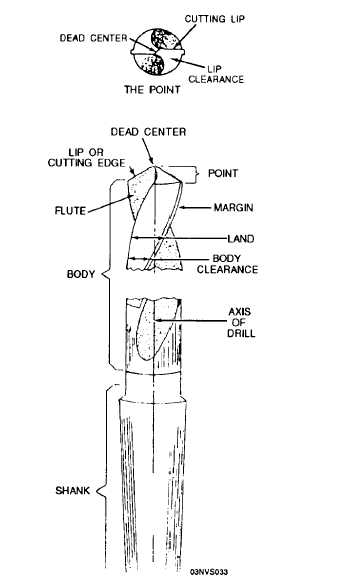Remember that the selection of grades of abrasive
cloth, the application of oil, and the cleaning between
grades applies to polishing, regardless of how the
cloth is held or used.
Care of Files
A new file should be broken in carefully by using
it first on brass, bronze, or smooth cast iron. Just a
few of the teeth will cut at first, so use a light
pressure to prevent tooth breakage. Do not break in
a new file by using it first on a narrow surface.
Protect the file teeth by hanging your files in a
rack when they are not in use or by placing them in
drawers with wooden partitions. Your files should not
be allowed to rust – keep them away from water and
moisture. Avoid getting the files oily. Oil causes a
file to slide across the work and prevents fast, clean
cutting. Files that you keep in your toolbox should be
wrapped in paper or cloth to protect their teeth and
prevent damage to other tools.
Never use a file for prying or pounding. The tang
is soft and bends easily.
The body is hard and
extremely brittle. Even a slight bend or a fall to the
deck may cause a file to snap in two. Do not strike
a file against the bench or vise to clean it – use a file
card.
Safety
Never use a file unless it is equipped with a
tight-fitting handle.
If you use a file without the
handle and it bumps something or jams to a sudden
stop, the tang may be driven into your hand. To put
a handle on a file tang, drill a hole in the handle,
slightly smaller than the tang. Insert the tang end, and
then tap the end of the handle to scat it firmly. Make
sure you get the handle on straight.
TWIST DRILLS
Making a hole in a piece of metal is generally a
simple operation, but in most cases an important,
precise job. A large number of different tools and
machines have been designed so that holes may be
made speedily, economically, and accurately in all
kinds of material.
To be able to use these tools efficiently, it is
important that you become acquainted with them. The
most common tool for making holes in metal is the
twist drill. It consists of a cylindrical piece of steel
with spiral grooves.
One end of the cylinder is
pointed, while the other end is shaped so that it may
be attached to a drilling machine. The grooves,
usually called FLUTES, may be cut into the steel
cylinder, or the flutes may be formed by twisting a
flat piece of steel into a cylindrical shape.
The principal parts of a twist drill are the body,
the shank, and the point (fig. 1-33). The dead center
of a drill is the sharp edge at the extreme tip end of
the drill. It is formed by the intersection of the
cone-shaped surfaces of the point and should always
be the exact center of the axis of the drill. The point
of the drill should not be confused with the dead
center. The point is the entire cone-shaped surface at
the end of the drill.
Figure 1-33.-Twist drill nomenclature.
1-21



